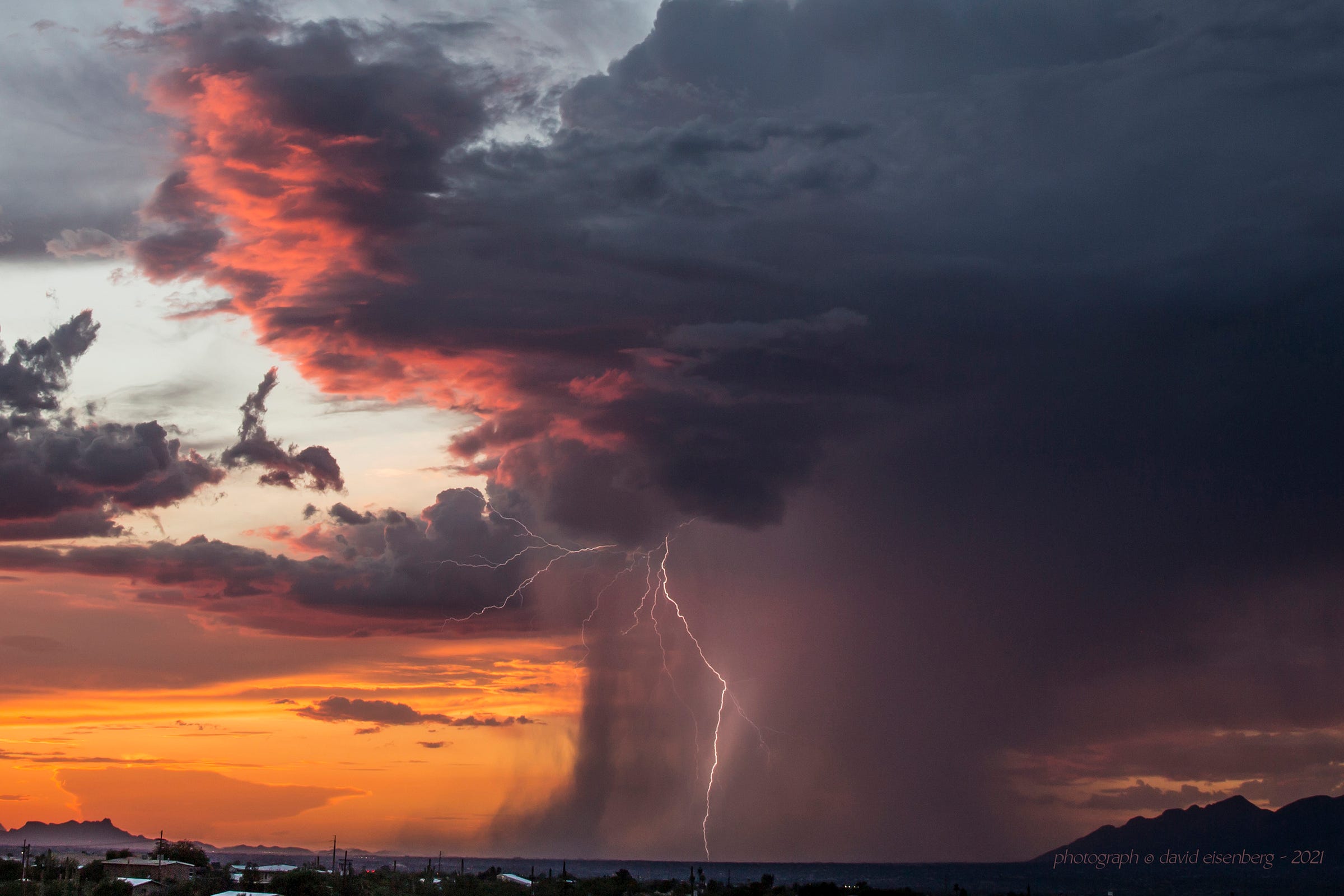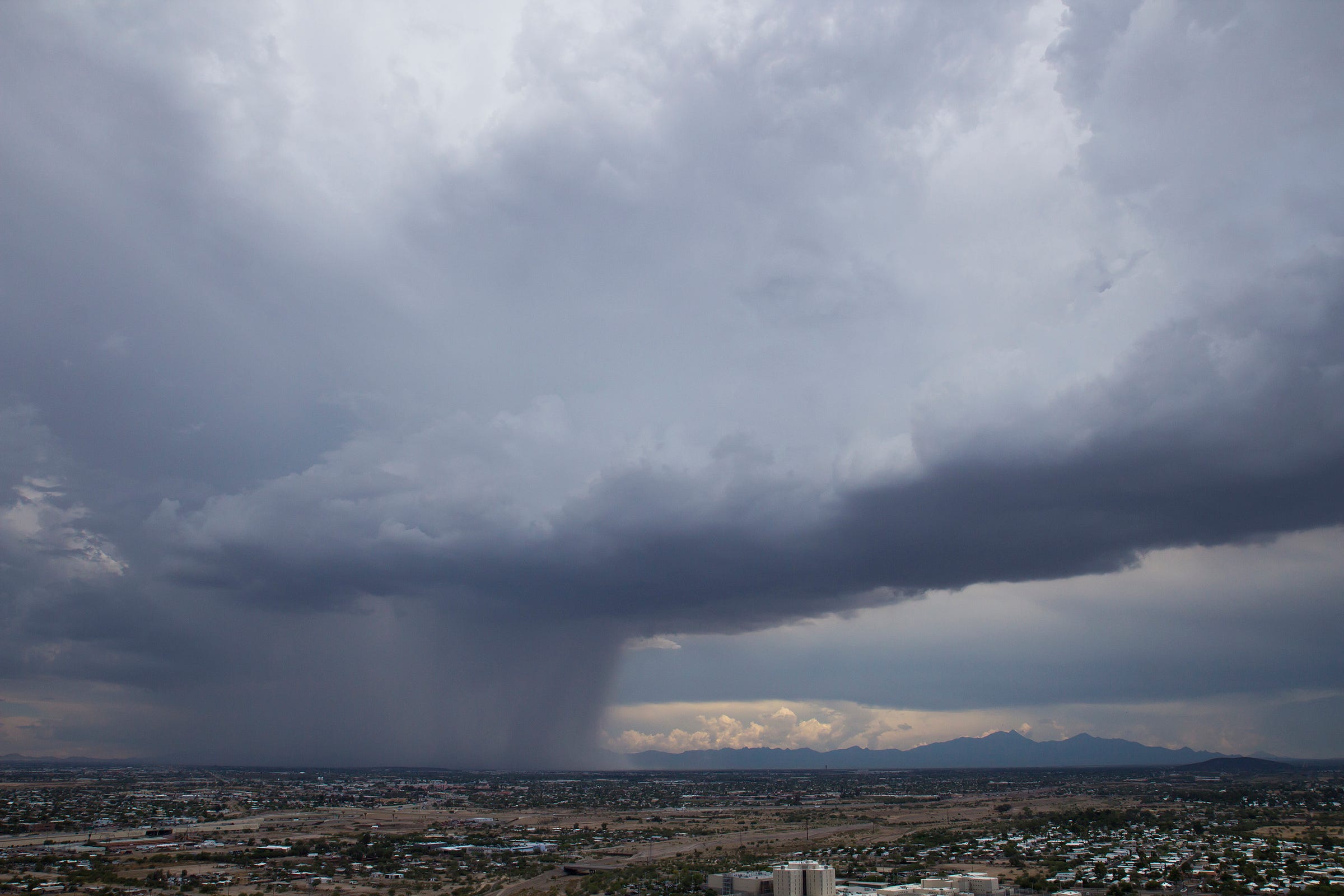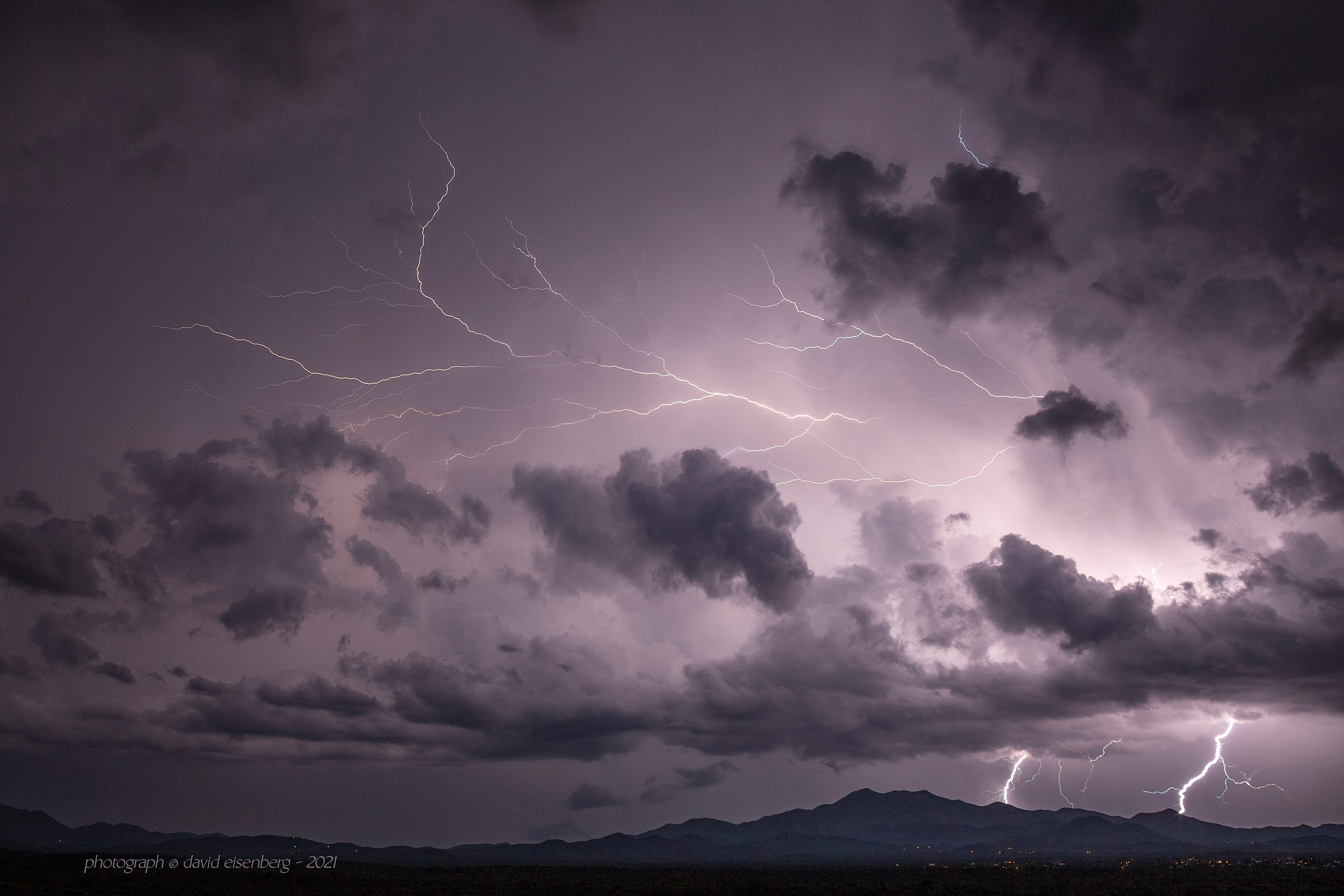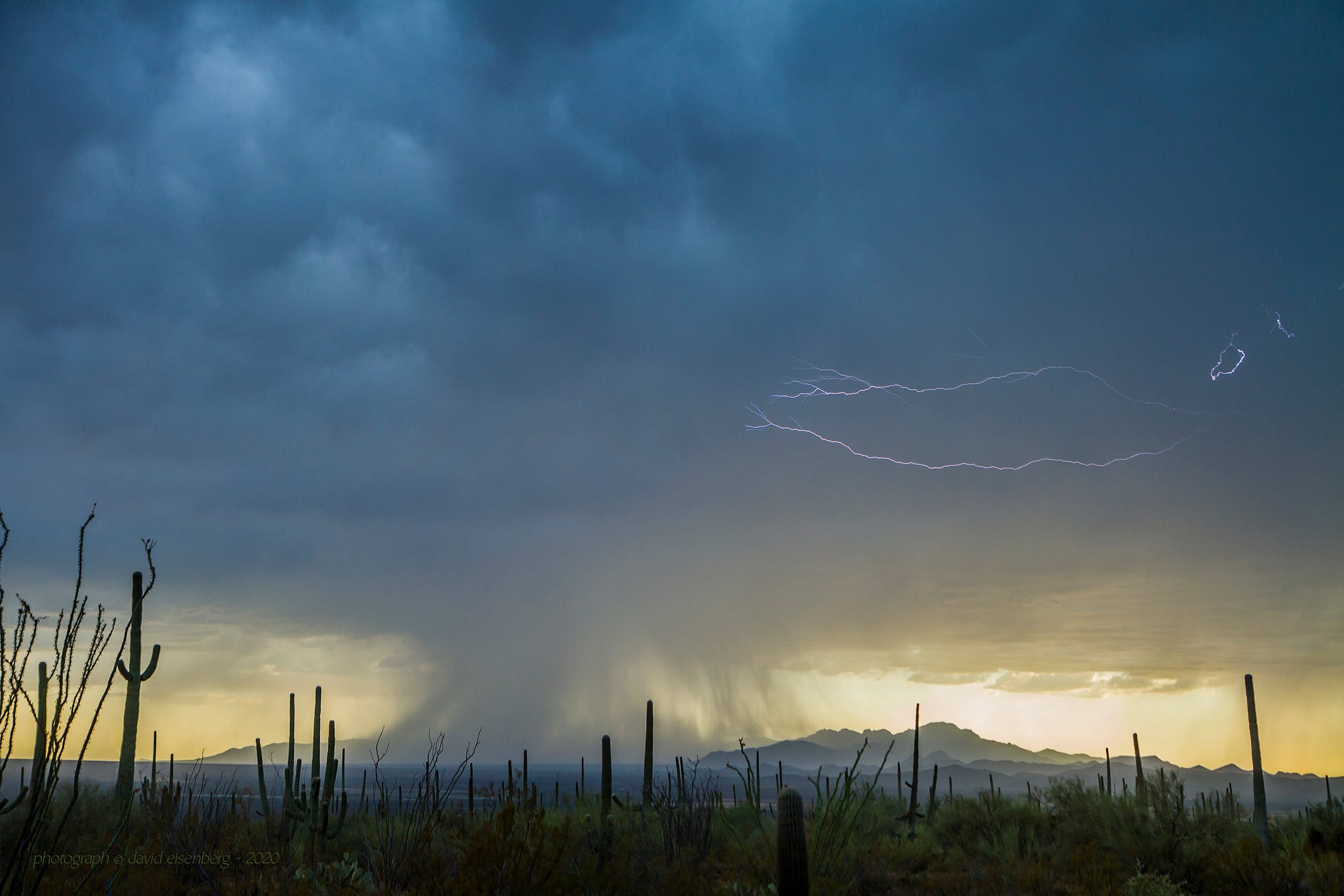Climate Tucson: It's Monsoon Time!
The sky watch begins for the glorious reason why we love summer

Read the story online here. Read more local stories at the Tucson Climate Report.
Monsoon season begins today and ends Sept. 30. Oh, happy days, maybe.
Ask a meteorologist in Tucson about the chances of a bountiful monsoon season and the answer is always “50-50.” Welcome to the Sonoran Desert’s most unpredictable, ethereal time of year.
There is a snarky saying that “you don’t deserve our winters if you haven’t spent a summer here," a reference to the snowbirds who enjoy winters and early springs but flee at the first sign of 90-degree weather, which we consider the balmy days before the Big Event that brings its own fireworks, chills, thrills, jaw-dropping Day-Glo sunsets — and a most wondrous aroma that naturalist and Tucsonan Gary Nabhan introduced to the rest of the world through the title of his 1982 book, “The Desert Smells Like Rain.”
(Late-breaking news: Nabhan just won a James Beard Media Award, the first ethnobotanist and Tucson author — we have many — to win the honor. Read the story in today’s Star.)
The desert smells like rain is a refrain that longtime residents take to heart. To me the heavenly scent is a mix of the sweet smell of a wet kitten with undertones of fresh blooming creosote and a dash of dust.

I lived in San Francisco for years before moving home to Tucson and it was maddening in the summer to, yes, spend one of my coldest winters there every August. Listen when the guidebooks advise bringing along a jacket if visiting SF in the summer.
Sorry to say, but it was “we-told-you-so” entertainment to see a gaggle of tourists in their shorts and t-shirts huddled to keep warm as they loaded onto the cable cars for a bell-clanging ride to the Embarcadero.
In summer, the view from this dock along San Francisco Bay is mostly just the towers of Golden Gate Bridge peeking out above the monstrous fog like thick smoke pouring in from the Pacific Ocean. The hotter it gets inland toward Sacramento, the deeper the fog banks get in the City. Picturesque on a postcard, frigid to live inside.
I was happy to get back, like JoJo, to where I belong.
Must be the Season of the Winds
Most Tucsonans who live here year-round by choice enjoy the heat, or at least accept that this is the climate they live in and take vacations where summers are milder.
Here, hot is a relative condition, speaking historically due to what this blog is about, global warming. The projected uncomfortable and dangerous hotter days are already appearing in the forecast. We’ve had a half-dozen “Excessive Heat Warnings” from the National Weather Service over the past few weeks. But that doesn’t mean we can’t appreciate what’s at hand. And that is, hopefully, a lively monsoon season.

The good news, and the reason we can survive June, one of the hottest months, is that the hotter it gets the greater the chance of attracting rain-heavy monsoon thunderstorms, a similar meteorological setup to San Francisco fog and inland heat.
Clearly a force of its own making, the particular conditions required to create the monsoon storms, when met, create a celestial show the proportions of which outrank the fiery battles of Valhalla. It’s true. Ask anyone.
The word monsoon is derived from the Arabic mausim, which means “season of the winds.”
In the case of monsoon season in southern Arizona, our normal westerly winds shift to the south, picking up moisture as they track north from the Pacific across the Gulf of California, over the Sierra Madre range in central Mexico, sometimes northwest from the Gulf of Mexico, scooping up moisture as they blow.
Rain is made when these wet winds collide with the hot and dry, “rural, rugged and arid” moonscape of the Four Corners area of New Mexico, Colorado, Arizona and Utah.
The dark green splotch on the map below indicates that the chances for rain over the next week look good. If all other conditions are met, including higher-than-normal temperatures.
Like a convection oven cooks food, hot air fuels the monsoon storms. If all systems are go, Four Corners becomes the incubator of a legion of cumulonimbus clouds — or thunderheads — attracted to the earth by upward draughts of surface heat. The heat in its way punctures these clouds laden with moisture and like the flow from a giant spigot water pours out on the dry ground below.
Did You Say 50,000 Degrees F?
Sometimes monsoon thunderstorms can hit so fiercely that they take one’s breath away — and also deliver life- and property-threatening floods and flash flooding. Lightning strikes are in the mix, too. So is hail. A thunderstorm that sits above your home, with its shattering booms, is both terrifying and exhilarating.
More frightening is to know that the lightning bursting above you is so powerful that it ignites the thunder. When those bolts reach 50,000 degrees F, like the fuse on dynamite they blast the clouds and cause “the air to explode outward,” according to NOAA. That’s hotter than the surface of the sun.
Monsoon season also attracts storm chasers, like David Eisenberg, whose photos are shown here, a Tucson resident who takes off at a moment’s notice when the time is ripe. To that end, meteorologists have a measure for how hot it needs to be to attract the thunderstorms. It’s known as the dew point.

“Foresummer” Is the Key to Turning on the Rainy Season
Monsoon as a calendar-driven event wasn’t official until 2008 when Arizona weather agencies, as a matter of research and meteorological practicalities, declared that monsoon started June 15 and ended September 30, according to the ASU School of Geographical Sciences and Urban Planning.
Botanists with the Arizona-Sonora Desert Museum also count monsoon as the fifth season in the upland (ours) region of the Sonoran Desert. Yes. Five. So when someone whines that we have no seasons here, they have no standing because we boast:
Winter (December through January or sometimes February, depending on the weather);
Spring (maybe February but always March and April);
Foresummer or the dry season (May through June);
Monsoon (July through September); and
Autumn (October and November).
How long these designations will last as the planet and our desert continue to warm is anyone’s guess. But it is, for now, the juncture of foresummer and monsoon that counts when it comes to rain.
The Heat Beneath Our Feet
In order for those thunderheads to be breached and send the rains tumbling into our washes and dry riverbeds the ground has to reach and hold a certain temperature for three consecutive days. That temperature is the dew point, which has to do with things like precipitable water in the atmosphere and condensation. But we can track the dew point without having to know all the details just by checking out the Star’s daily weather page.

For example, today, the first day of monsoon season, the dew point around noon was 27 degrees thereabouts and will rise as the temperature increases. Yesterday, June 14, the dew point topped out at 45.3 degrees. Neither one make the grade for rain.
Meteorologists have set the optimum dew point for luring the thunderstorms at 54 degrees F in Tucson (55 degrees F for Phoenix) for those three important days. In general, it requires average temperatures of at least 105 degrees F to boost and hold the dew point in Phoenix and bit lower for Tucson.
Last Word
Climate scientists say that predicting heat is straightforward enough. But precipitation is a more difficult call. For now, the jury is out on how climate change will alter our monsoon season pattern. The one thing known is that the excessive heat waves we’ve had and will have — here and across the globe — are accelerating the amount of moisture being released from the sky. Flooding is the result.
So there is the possibility that one of our monsoon storms could dump a lot of water into our watershed. Pima County is currently beginning work on a major infrastructure project at Finger Rock Wash near Skyline Drive and Columbus Boulevard and levee improvements at the Cañada Del Oro wash.
In both cases, the Big Horn fire in the Catalinas three years ago altered the terrain and the subsequent flow of runoff.
The one thing that climate change has driven home is that everything is connected.




Nice essay, Karen!